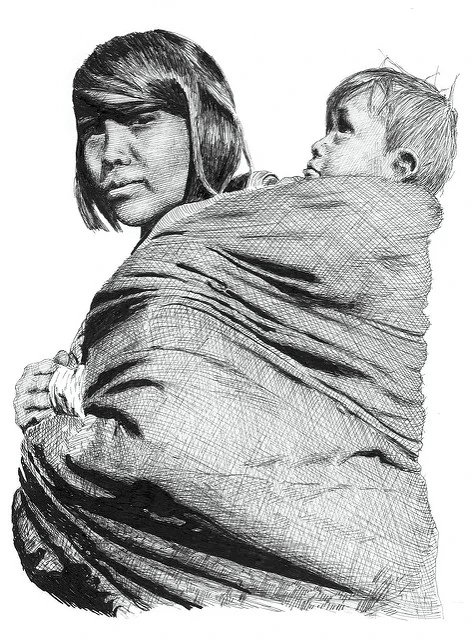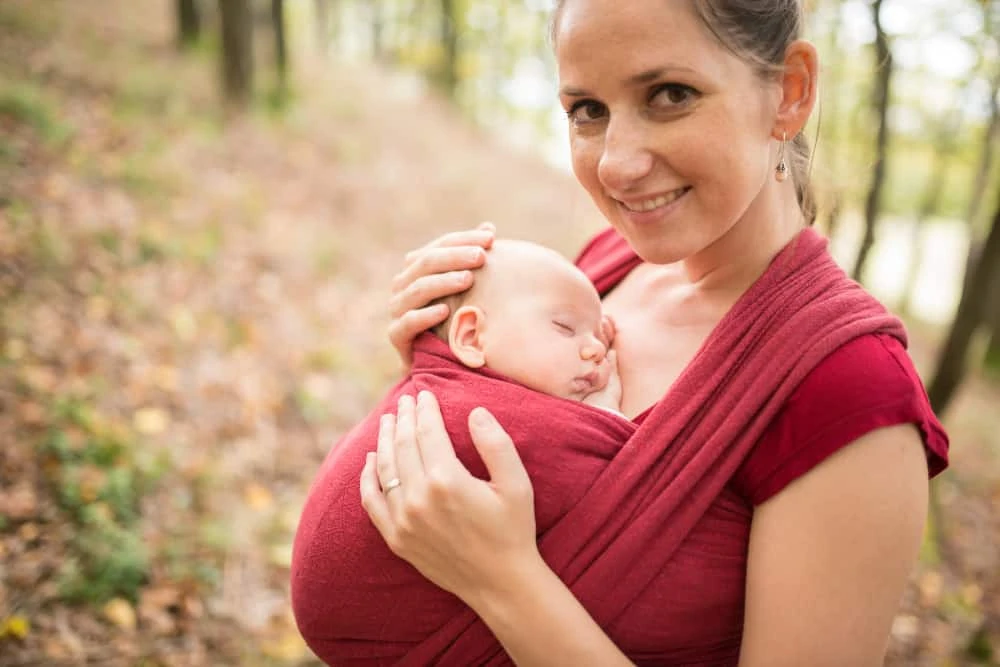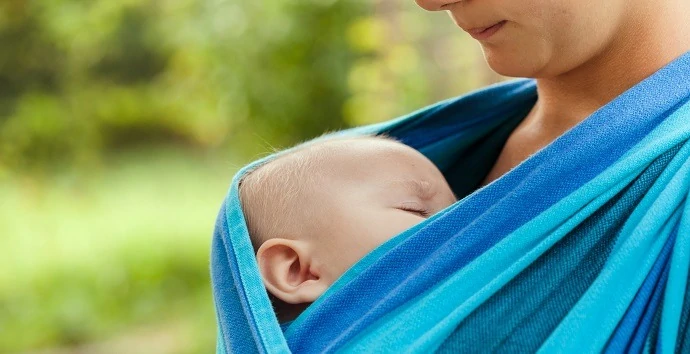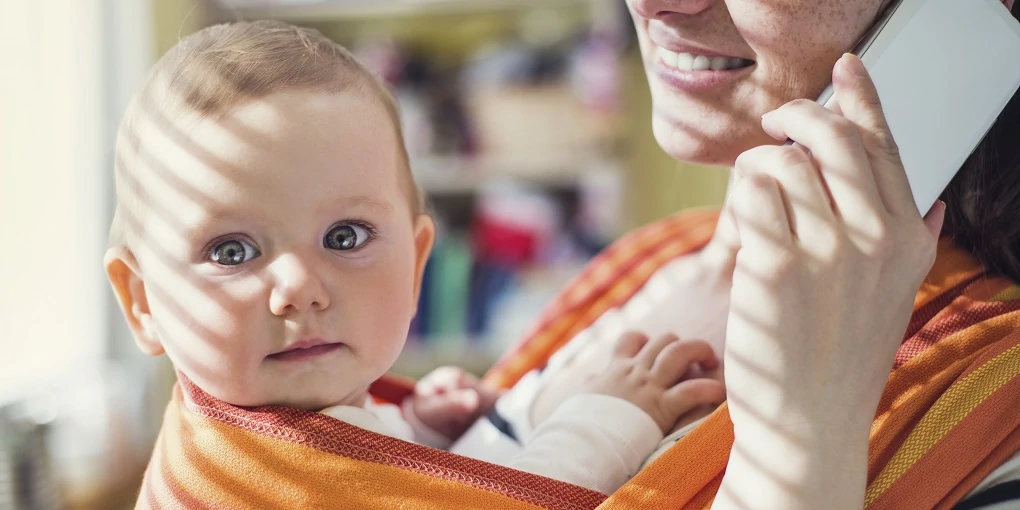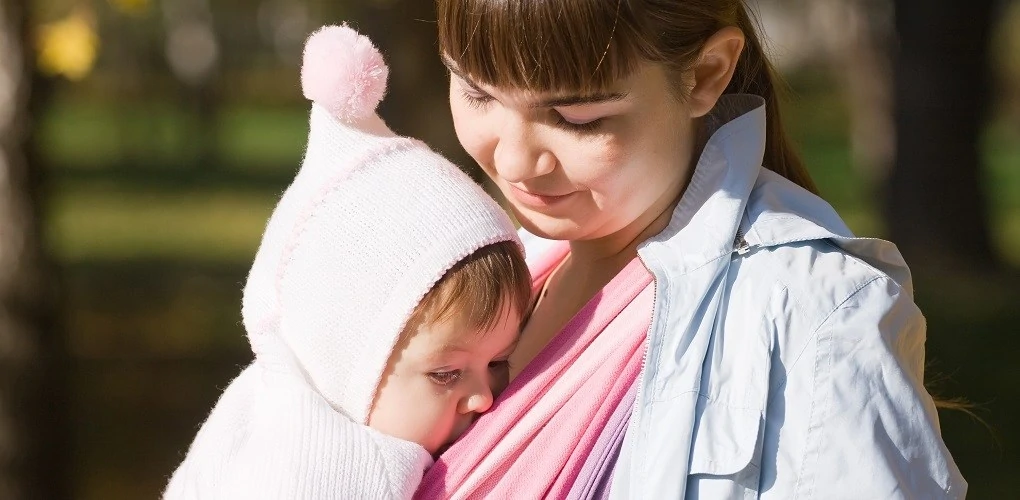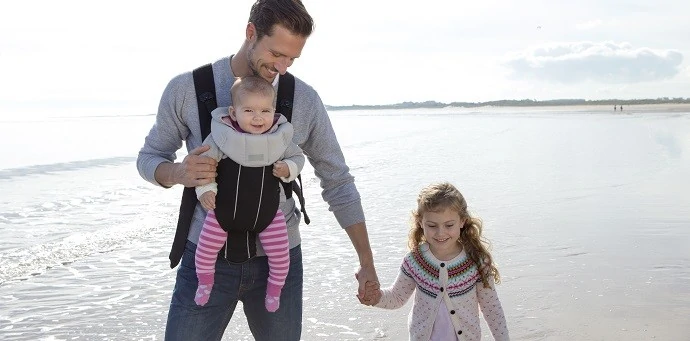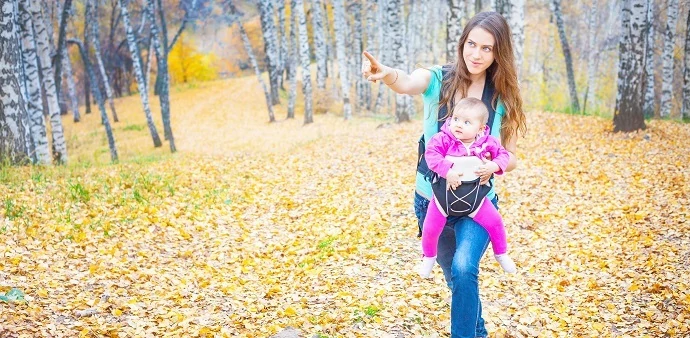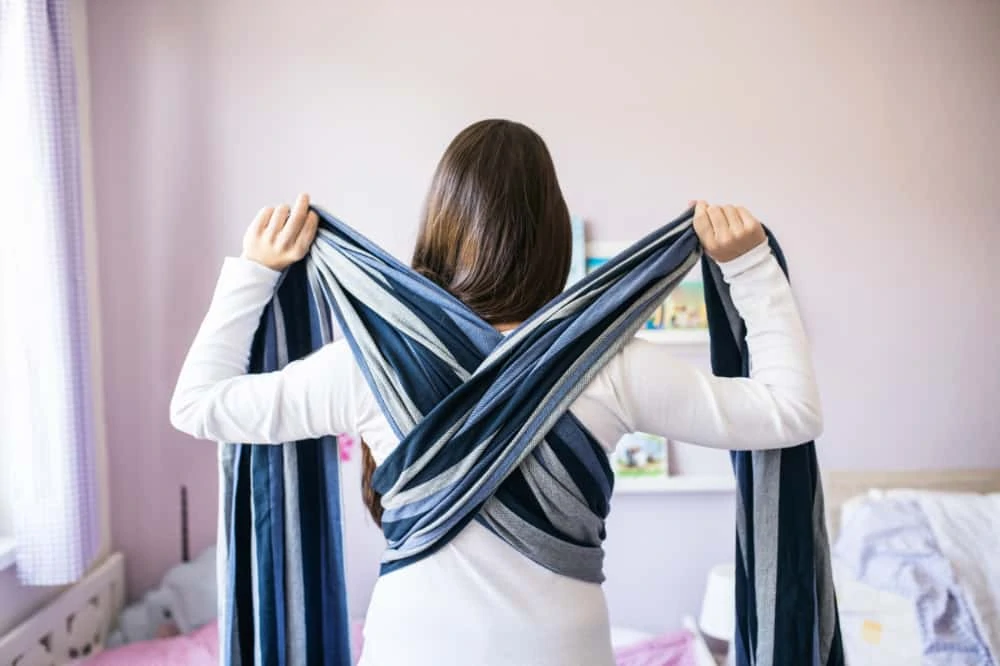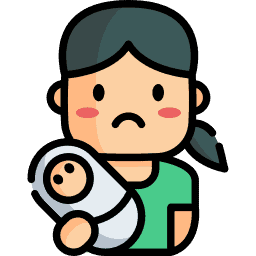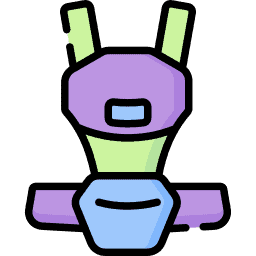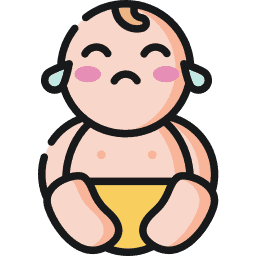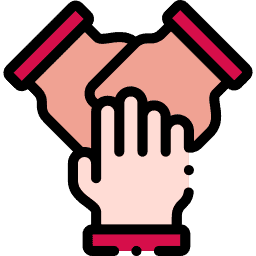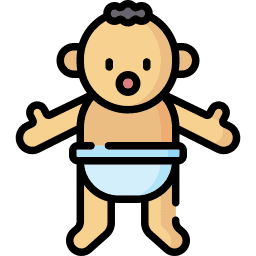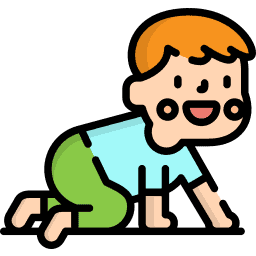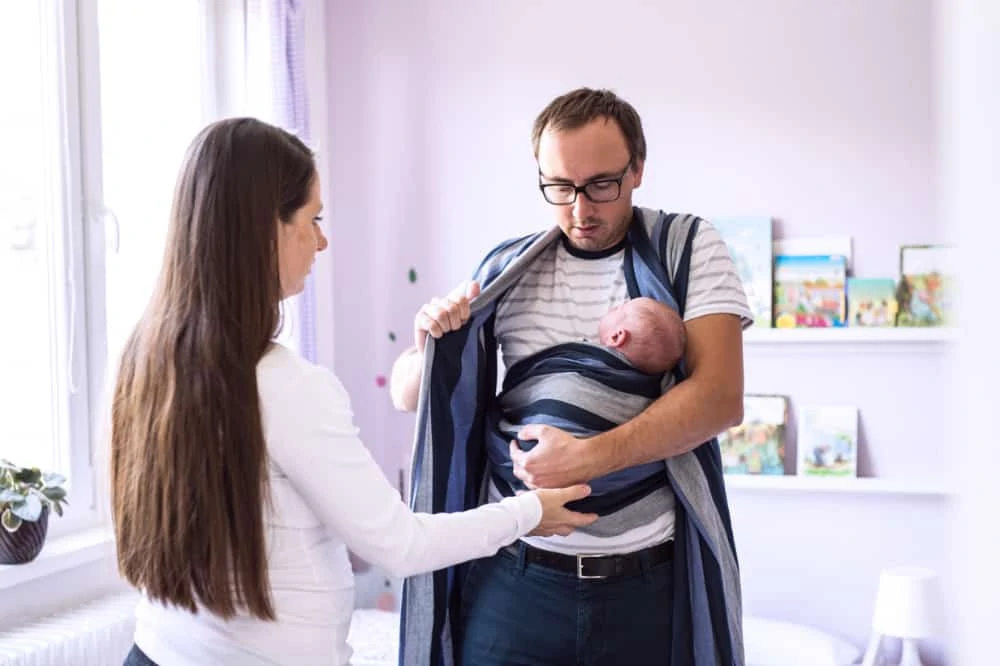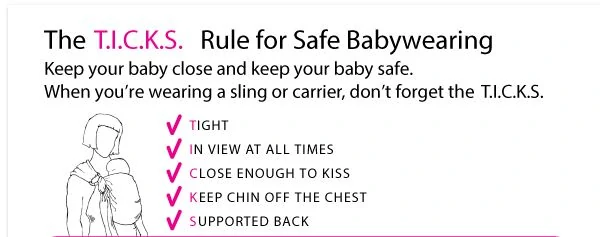Babies can seem incredibly heavy if you carry them around all day, but for a busy mom, there isn’t much choice.
New moms often have a million different things they need to get done. Going grocery shopping, fitting in some exercise, cleaning, paying bills, just to name a few. And for all those activities, baby is going with you.
The good news? There is a much easier way to lug your baby around. It’s called babywearing.
In this article, we will teach you everything you need to know about the benefits of babywearing. And how babywearing can help save you time and energy.
What Is Babywearing?
The word babywearing might be new to you, but the practice has been around a long time. Parents have been doing it for centuries in many different cultures and places, including in the U.S. when it was a popular way for Native Americans to carry their babies around.
Babywearing is simply carrying a baby around on your body, either in a sling or some other type of baby carrier. It has only been in the past two or so decades that babywearing has enjoyed a resurgence in the U.S. since its days of popularity with Native Americans.
Source: Flickr
The most common positions for babywearing include:
- The front carry with the baby facing in toward you. With this style of babywearing, you and your baby are always facing each other, which is nice for making eye contact and interacting.
- The front carry with the baby facing out — they’ll face the way you’re facing. That’s great for toddler carriers because older babies are always curious about the world around them.
- The hip carry so your baby will be at one side.
- The back carry — the baby’s chest will always be against your back and when you walk, your baby will see what you’ll see.
To get started with babywearing you’ll need some equipment — something to carry your baby in.
Some of the most popular types of carriers include:
- Stretchy wraps.
- Ring slings.
- Framed backpacks.
- Soft carriers.
- Bei Dais or Meh Dais (formally known as Mei Tais.)
- Pouch wraps.
- Babywearing shirts.
- Woven baby wraps.
Quick Tip
Each wrap will also be able to hold a varying degree of weight, so you’ll have to keep a close eye on that.
Benefits of Babywearing for Babies
If people have been babywearing for so long in other parts of the world, there must be a reason for it, right? Actually, there are lots of reasons why wearing your baby is a good idea. It can benefit both moms and babies physically, emotionally and it can even help breastfeeding efforts.

Here are some of the biggest perks of babywearing for your child.
1. It’s Good for Cognitive & Social Development
If you’re wearing your baby rather than having them sit in a pack ‘n play, stroller or car seat, they have a chance to be more socially engaged, both with you and the world around them. They’ll hear you talking with others and even hear you talking to yourself at times — that will help with their language skills.
Plus, the different settings they’ll find themselves in will stimulate their senses. They’ll get the sensation of walking when you’re moving along — if you stop suddenly or turn around, they’ll feel those sensations too. Those changes of scenery and movement can be thrilling for a baby.
2. It Prevents Flat Head Syndrome
When a baby stays on their back too much, they run the risk of developing a flat head, which is known as plagiocephaly (1).
Plagiocephaly is preventable if you hold or wear your baby instead of letting them stay on their backs all the time in cribs, baby swings and pack ‘n plays.
If your baby gets a severe case of plagiocephaly, they may have to wear a helmet to correct it.
3. Your Baby May Cry Less.
Wearing your baby for the first few months can result in 43 percent less crying as a whole and 51 percent less in those precious evening hours when you’re also trying to get some sleep (2).
Getting more sleep can boost your immune system, which means you’ll be less likely to get sick. And if you aren’t sick, your child is less likely to get sick since most of their contact is with you.
Did You Know?
You won’t feel as stressed either if your child cries less. Constant crying can really take a toll on everyone involved, in the form of child abuse, depression, and anxiety.
4. Baby Wearing Feels like the Belly
When your baby is in your belly for the nine months of your pregnancy, it gets used to hearing your heartbeat and feeling your breathing. Plus, it becomes used to swaying with you as you walk along and go about your day-to-day business.
Your baby will still thrive from that close contact after it is born. Wearing your baby in a carrier will be reminiscent of carrying it around in your belly (3).
5. More Consistent Weight Gain
When you’re babywearing, your boobs are right by your baby, unless your baby is riding in a backpack carrier. But when they are infants, when you’re still learning the ins and outs of breastfeeding, they’ll be in a front carrier because their heads and neck won’t be supported enough to ride in a backpack.
With your chest right there for a constant reminder, your baby may want to feed more than it would otherwise (4). So if you have a finicky eater or if your pediatrician has been telling you your breastfed child isn’t gaining enough weight, you might want to try a carrier and see if that helps.
6. Stable Heart Rate and Body Temperature
Your baby’s heart rate can be too low at times and it can be too high at other times. The best place to be is in that Goldilocks zone where it’s more in the middle. Babywearing can help your baby’s heart rate stabilize so it is in the optimal zone.
Wearing your baby can also help your little one have a more stable temperature.
7. Hip-hip-hooray! It Can Be Good for the Hips
Hip dysplasia is a problem babies sometimes experience in the first few months of their life. When babies have hip dysplasia, it means their hips are compromised because they haven’t formed correctly. That can lead to problems such as dislocation (5).
Tight swaddling can lead to problems with your baby’s hips over time. But when done correctly, babywearing can help babies keep their hips in a position that promotes strong, healthy hips.
You may prefer a wide-based carrier for your comfort, but the evidence seems to suggest that narrow-based carriers have absolutely no correlation with Developmental Dysplasia of the Hip (6).
8. Babywearing Can Help Fight Colic
Colic is intense, both for moms and their babies. Any mom who has dealt with a colicky baby knows that feeling of desperation you get when your baby starts crying and nothing seems to make it stop. You’d be willing to try anything for just a few minutes of peace. You might be in luck. Babywearing could be the weapon you’ve been looking for.
Babywearing can reduce colic. The exact reason isn’t completely proven, but experts believe it may be the additional human touch that makes a colicky baby cry less.
Plus, babies spend more time in an upright position in carriers than they would if they were on their backs in a pack ‘n play or in a recumbent swing. That additional vertical time may help keep their stomach contents down, leading to a more comfortable baby.
9. Your Baby Will Get Better Sleep
Your baby loves to be around you. Just your presence and touch is enough to calm it down and relax it. Wearing your baby will cause it to have less stress and crying, which will be good news for both of you. Hearing your baby cry causes you stress too and as a new mother, you don’t need any more stress.
Sleeping right next to you will help your baby breathe more evenly and peacefully (7).
10. It Can Help Preemie Development
Human touch is a wonderful thing. It can help babies feel loved and calmer, and when you have a preemie, it can help them gain weight and thrive.
By feeling your skin against theirs, your preemie can reap a host of benefits that will help as they struggle to catch up to the development of full-term babies. They’ll gain extra weight because of babywearing and they’ll sleep better (8).
Preemies already have a battle on their hands. As a parent, you’ll want to do anything you can to tip the odds in their favor.
Benefits of Babywearing for Moms & Dads
Moms and dads can get a lot out of babywearing, including relieving some of the stress on our poor arms. Sometimes it’s amazing how much stuff, including our babies, that we’re expected to lug around as moms.
But there are other benefits as well.
11. Freedom and Convenience.
Moms are multi-tasking queens — if there’s a way to do three things at once, we’ll find it. But when we have a newborn on our hands, all bets are off. Our first concern is taking care of that baby. But that doesn’t mean we stop thinking about all the other things we need to check off our to-do list.
Babywearing gives us our hands and freedom back. It’s easier on our bodies too.
Did You Know?
I’m not surprised by that figure. As someone who has always struggled with upper body strength — just ask my high school physical education teacher who was always appalled at how few push-ups I could do — carrying my baby around for extended times took a big toll on me. Before I found a baby carrier I liked, my arms hurt so badly from the extra weight that I suddenly had to carry with me everywhere I went. When I started using a baby carrier, I felt like me again.
12. It Reduces Postnatal Depression.
Postnatal depression is an ugly reality for some women. The moment they’ve looked forward to for so long can leave them feeling down and gloomy. They find themselves unable to enjoy all the moments they thought they would savor.
But while they are battling their depression, they may feel less guilty about their condition if they practice babywearing. They won’t have to worry about their baby being cheated out of a loving mother because the constant contact that goes along with babywearing may make up for the lack of smiles they’re giving their baby (10).
It can also help with depression because you’ll be able to do things like going for a walk outside without having to navigate a heavy stroller.
13. Easier Breastfeeding In Public
Unless you’re at home, it can be difficult to breastfeed. If you use a blanket to cover up with while you’re breastfeeding, it can be tricky getting your baby to find your nipple and latch on correctly. It can be like a frustrating game of hide and seek.
With a baby carrier though, your baby will already be cuddled against your chest so they’ll be in close proximity to the right spot already. That will make it easier for your baby to find your nipple and latch. As they become more used to the baby carrier, breastfeeding in there will become routine.
You’ll also have some built-in privacy whether you’re feeding your baby in a restaurant or at a friend’s house. Some women who might ordinarily consider breastfeeding are turned off of it because of their lack of privacy, so this is a good solution for them.
14. You’ll Save Some Money
Strollers can be so expensive that it can be hard to make that final purchase, especially when you know you could put that money to good use elsewhere. Baby carriers are more cost-effective, which is attractive for moms who are worried about money. They cost a fraction of what a good stroller does.
15. It Helps You Form Closer Bonds
As a mom, you bonded with your baby before it was born. To keep that close connection going, babywearing is a great option. You’re constantly with your baby. You can talk to them, sing or snuggle whenever you want to.
You can also become more in-tune with your baby’s needs. It won’t take loud crying to let you know your baby wants something. You’ll start picking up on their signals before it reaches that point. Because of that, you’ll feel more confident in your parenting skills (11).
This perk of babywearing won’t just extend to you — it also will work for grandparents and dads who want to use baby carriers too. They’ll form a closer bond with your child and they’ll feel more connected to them and more confident in their caregiver abilities.
16. Spend More Time With Your Older Children
When you have more than one child, time management can get a bit tricky. It feels at times like you’re ignoring your older child because your infant requires so much help. That can lead your older child to view the new one as a threat.
Babywearing can solve that problem by freeing up your hands so you’ll have time to spend with both kids. You can spend time with your oldest child doing the things you did before the new baby arrived. Even better, your oldest child will get to spend time having fun with your baby.
By babywearing, your infant will fit into your child’s world and be seen as a playmate rather than as competition.
17. It Keeps the Creepers and Germs Away
One of the things I hated most as a new mother was strangers and their germs. I once had my 6-week-old baby out for a walk in a stroller when a woman eating chips approached us. She went right up to my daughter and started touching her face, her hands and her feet while talking about how precious she was.
A baby carrier would have prevented that situation. The lady wouldn’t have been able to get her chip crumbs all over my baby that way. That protection from strangers is a great reason to wear your baby, especially in crowds where you don’t want to lose sight of your baby for a minute.
18. You Can Go Anywhere While Babywearing
Pushing a stroller around some places can be difficult. If you’re on a crowded sidewalk, you can struggle to find enough room to wheel that stroller through the crowd.
Going for a hike can be a problem too. Trying to get through the grass, uneven trails and slopes you’ll encounter can give both you and your baby a really bumpy ride. With a hiking carrier, your baby will get a smooth ride.
19. It’s Easier to Exercise and Lose Weight
As every mom out there knows, that baby weight doesn’t magically fall off in the delivery room.
It took you nine months to pack on the pounds and it’s going to take a long time to take them off too. The big problem with losing the weight is that you have no time to do it. Every waking minute is spent with your baby.
To start torching some calories, exercising while babywearing is a godsend. You can go out for long walks without worrying if there are sidewalks the way you have to with strollers. You can walk through the grass if you have to with your baby carrier, while wheeling a stroller through the grass has you sweating and breathing hard in a minute or two. You’re limited where you can go with a stroller. It’s much easier just to strap on your carrier, grab your baby and go.
20. Your Milk Supply Should Increase
If there’s one thing new breastfeeding moms worry about around the clock, it’s their milk supply. An intense breast pumping session may only yield a couple of measly ounces of breastmilk when it feels like there should be a whole carton for that amount of effort.
By going skin to skin (also known as kangaroo care) with your baby by babywearing you can increase your milk supply a bit. That close constant contact with your baby may also help you achieve a faster letdown with your milk.
It’s not like your milk supply will suddenly turn into a geyser, but every little bit helps when you have a hungry, growing baby to feed.
21. Connect With Other Like-Minded Moms
As we all know, it takes a village to raise a child. That’s why it’s so important for moms and dads to connect with other parents and share their experiences. It can be difficult to meet people when you first become a parent, but babywearing gives you the perfect conversation starter.
In my experience, parents who babywear are often delighted to meet and connect and share their tips, tricks, and experiences with other babywearing moms and dads.
Babywearing meetups can be easily found in your city (or online), and there’s even the annual International Babywearing Week which aims to raise awareness and normalize babywearing in society.
10 Common Babywearing Myths
Anytime a new way of doing things begins to take root, there are going to be naysayers. They’ll want to tell you why the new idea isn’t as good as the old one or why they believe the new one won’t work. If we always listened to myths and stuck with old ways of thinking, we’d still believe the Earth was flat.
Babywearing isn’t immune to myths, but in order to convince women to take a critical look at babywearing to see if it’s right for their situation and lifestyle, we need to separate fact from fiction. After all, some of the women dissing babywearing have never even tried it.
Here are some of the top babywearing myths and the truth about them.
What is International Babywearing Week?
International Babywearing Week (IBW) is an outreach event that is held every year in October. The aim is to provide a week-long opportunity for the celebration and promotion of the many benefits of babywearing.
Non-profit organizations and babywearing chapters all around the world are invited to participate in IBW. To do so, the organization needs to register as an Official Celebrating Organization. Celebrations can take the form of online and in-person events that happen right throughout the week. IBW is widely promoted through the use of social media using the hashtag #internationalbabywearingweek.
Each year the event is assigned a different theme. In 2019 IBW was held between September 31st – October 6th and the theme was “Babywearing Has….”. This encouraged parents and enthusiasts to think about how babywearing has enriched and changed their lives.
How to Wear Your Baby Safely
Babywearing can be a great thing for both you and your baby, but you need to pay attention to certain safety precautions when you’re doing it.
If you remember the TICKS rules, your baby will have a safe ride. Here are the components of TICKS (15).
- Tight: Your carrier has to fit you tightly to keep your baby supported enough for a safe ride. If fabric isn’t pulled tight enough when you’re wearing a wrap, your baby can shift positions and slide down, which may affect its breathing. If your baby shifts too far downward, it can put unnecessary strain on your back.
- In view always: You have to be able to see your baby’s face at all times. You shouldn’t have to push aside fabric to spot their face. If you do, that could mean they aren’t getting enough air.
- Close enough for a kiss: When you’re wearing your baby on your chest, its head should be positioned close to your chin, so close that could lean your head down and give them a kiss.
- Keep their chin off their chest: If your baby’s chin is on its chest, you need to readjust their position immediately. That can make it harder for them to breath. An easy way to check if there is enough space is to give it a hand test. If you put your hand under their chin, there should be room for at least one of your fingers between their chin and chest.
- Supported back: A baby’s back should be supported — you don’t want them leaning back, sagging away from you. They should be tucked up against you, with their tummy and chest touching you. If they are leaning back, slumping, it can make it more difficult for them to breath.
You should also give your baby carrier a once over after every use. Damage can occur at any point or even without knowledge, for example, in a car door, someone standing on it, your adorable little dog chewing it. Make sure the material is still in good condition and that it’s holding up well. While you’re at it, check out any harnesses for signs of bending or breaking.
When you’re out using your carrier, you should always remember how to properly bend when you’re babywearing. If you want to pick something up off the ground, make sure to bend your knees to get it and use your other hand to support your baby (16). Never bend at the hips because your baby could fall from the carrier.

